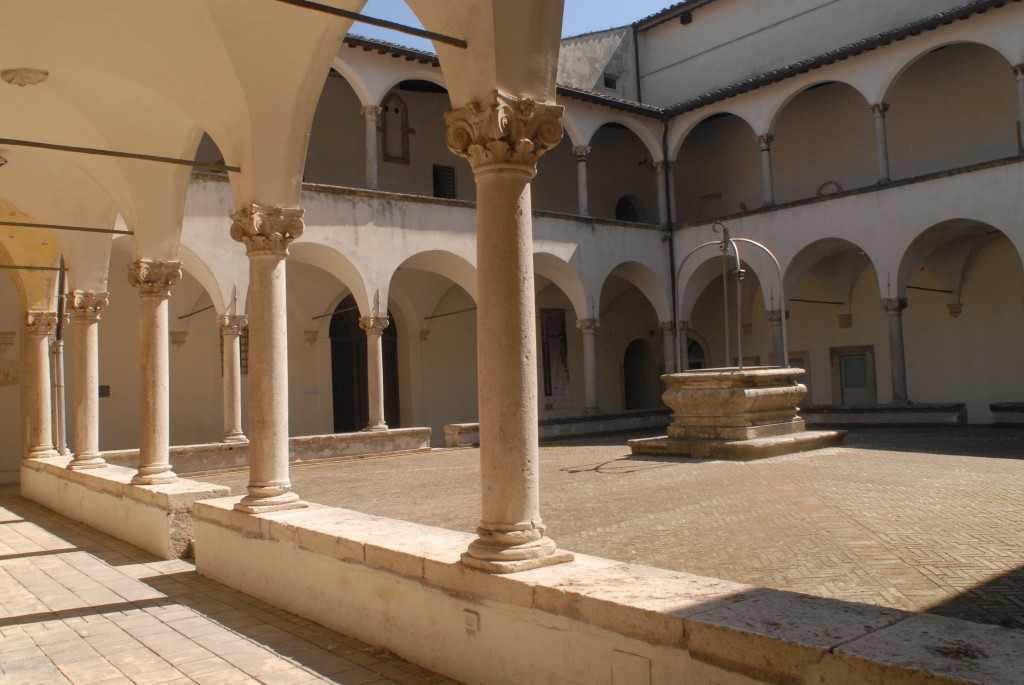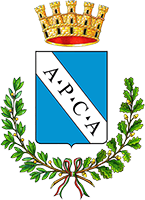
Next to the church, there is the former convent of the Franciscan friars. At the beginning of the sixteenth century, under the direction of Fra Egidio Delfini (General Order of Friars Minor native of Amelia, remembered by an inscription above the entrance portal), an internal cloister was built, which is accessed from the square. The cloister is formed by a quadriportico ,adorned with frescoed lunettes surmounted by an upper loggia; the arches of the two overlapping orders are each supported by sixteen marble columns ending at the top with fine carved capitals. At the center, a well that still retains the original wellhead of the 16th century.
This harmonious spot is one of the most delightful of the whole complex. After the Unification of Italy (1861), the convent was expropriated by the Italian State and transformed into the famous Boccarini College, previously housed in another monastery. The former institution had been founded in 1601 thanks to a donation fund defined in the testament of Flavio Boccarini, who not only was a religious minister, but also the personal secretary of Pope Gregorio XIII and canon of St. Peter’s Basilica, from whom the college took its name. The college was entrusted to Salesians Fathers of Don Bosco in 1932, whilst in 2001 the ancient Franciscan convent was intended to house a multifunctional complex made up by the Archaeological Museum, the Municipal Gallery, the Public Library, some exhibition rooms and a Conference Hall.
Archaeological Museum and Municipal Gallery “Edilberto Rosa”
The archaeological collection on display from the ground floor to the second floor provides a chronologically complete overview of the history of Amelia. Numerous objects covering thirteen centuries of local history (belonging to some private collections or coming from the excavations in the Necropoli of the Ex Consorzio Agrario) were added to the original nucleus consisting of inscriptions and architectural elements collected during the excavations of the town and its suburbs that date back to the first decades of the 19th Century. Above all, on the first floor, a magnificent bronze statue of Germanicus stands out (1st century AD). It is the result of a chance find in 1963, when works were being carried out not far from the great walls of Amelia. The statue was in pieces, but it has been carefully restored and now, after a period in the National Archaeological Museum of Perugia, it pays homage to the city where it was discovered. Here, it is additionally valued by a recent multimedia setup and audio-visual equipment. This sculpture, just slightly larger than life-size, portrays the young Roman general (died in Syria on his return from a military campaign, in 19 A.D.) wearing a richly decorated armor.
The figure is holding a spear in his left hand, whilst his right hand is raised in the symbolic gesture of addressing the army. For this reason, the bronze probably stood in the campus of the Roman Town, that is the area set aside for the local youth to do their physical and military exercises. One large room on the second floor has been set up to house the Municipal Gallery. It mostly consists of 15th-18th Century paintings originating from churches in the town and its surroundings, such as the altarpiece by an anonymous follower of Piermatteo d’Amelia (about 1495-1500) and several works by Livio Agresti (Crucifixion with Saints Firmina and Olympias, dated 1557, probably coming from the Cathedral), Giacinto Gimignani (St. Michael defeating the Devil, 1677), Circle of Sebastiano Conca (The conversion of St. Jerome Emiliani, post 1767) and a portrait gallery of illustrious citizens of Amelia. On the first floor, a monographic room has been dedicated to Piermatteo d’Amelia (1445/48 – about 1506): the wood panel here exhibited, dated about 1474-75, represents St. Anthony the Hermit. The provenance of the painting is from the Church of St. John the Baptist, raised beside one of the various Franciscan monasteries diffused in the Amelia area.

LINK: https://ameliamusei.it


